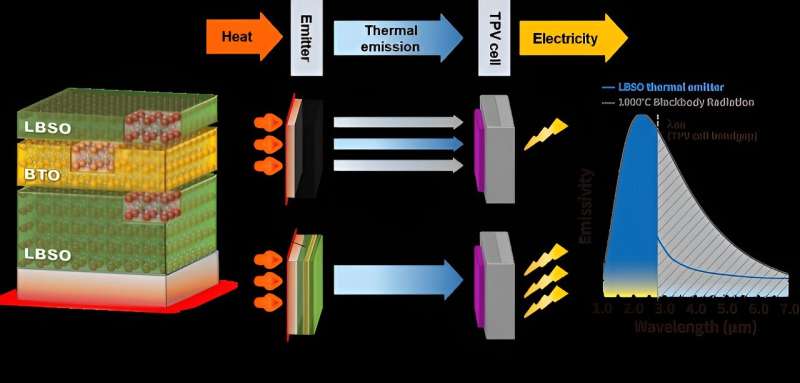This article has been reviewed according to Science X's editorial process and policies. Editors have highlighted the following attributes while ensuring the content's credibility:
fact-checked
peer-reviewed publication
trusted source
proofread
Researchers develop thermal radiation controllable epsilon-near-zero material that can withstand extreme environments

Thermal radiation is electromagnetic radiation emitted by all objects with temperature and most representatively, there is the solar radiation spectrum that enters the Earth and causes the greenhouse effect.
Controlling and utilizing the thermal radiation energy emitted from solar power, thermal power generation, and residual heat in industrial sites can reduce the cost of electricity production. Therefore, interest in radiation spectrum controlling technology is increasing in areas such as cooling, heat dissipation, and energy production.
Until now, radiation spectrum control technology has been mainly used in general environmental conditions, but recently, materials that can withstand extreme environments such as space, aviation and TPV system are needed.
A team led by senior researcher Jongbum Kim at the Nanophotonics Research Center has developed a refractory material for controlling thermal radiation spectrum that maintains optical properties even at high temperatures of 1,000°C in air atmosphere and strong ultraviolet illumination. The study is published in Advanced Science.
The team fabricated lanthanum-doped barium stannate oxide ("LBSO") as a nanoscale thin film with no lattice strain by pulsed laser deposition. Unlike conventional refractory conducting materials such as tungsten, nickel, and titanium nitride, which are easily oxidized at high temperatures, the LBSO material maintained its performance even when exposed to high temperatures of 1,000°C and intense ultraviolet light of 9 MW/cm2.
The researchers then fabricated a thermal emitter based on a multilayer structure with high spectral selectivity in the infrared band using LBSO, and found that the multilayer structure was stable to heat and light as with the single layer thin film, confirming its applicability to TPV power generation technology. The LBSO material allows thermal radiation to be transferred to the PV cell without any additional methods to prevent it from oxidizing in contact with air.
"As an alternative to solar and wind renewable energy, whose electricity production varies depending on the weather, eco-friendly thermoelectric power generation technology that uses radiant energy emitted by the sun and high-temperature environments to generate electricity is gaining attention," said KIST senior researcher Jongbum Kim. "LBSO will contribute to addressing to climate change and the energy crisis by accelerating the commercialization of thermoelectric power generation."
The researchers expect that LBSO can be applied not only to thermoelectric power generation technology and recycling of waste heat from industrial equipment, but also to technology for managing heat generated by exposure to and absorption of strong sunlight in extreme environments such as space and aviation, as it is highly resistant to UV exposure.
More information: Hyebi Kim et al, Perovskite Lanthanum‐Doped Barium Stannate: A Refractory Near‐Zero‐Index Material for High‐Temperature Energy Harvesting Systems, Advanced Science (2023). DOI: 10.1002/advs.202302410
Journal information: Advanced Science





















